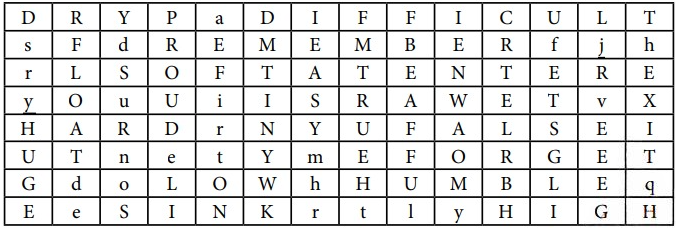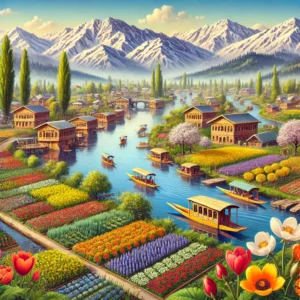SSLC English Question and Answer: Kashmir, The Garden of India
Looking for SSLC English Studies textbook answers? You can download Chapter 3: Kashmir, The Garden of India Questions and Answers PDF, Notes, and Summary here. SSLC English 3rd Language solutions follow the Karnataka State Board Syllabus, making it easier for students to revise and score higher in exams.
Karnataka SSLC 3rd Language English Textbook Answers—Reflections Chapter 3
Kashmir, The Garden of India Questions and Answers, Notes, and Summary
Class 10 3rd Language English Chapter 3
Kashmir, The Garden of India
Scroll Down to Download Kashmir, The Garden of India PDF
Comprehension I: Kashmir, The Garden of India
Question 1.
From where did the travellers enter the valley of Kashmir?Answer:
The travellers entered the valley of Kashmir at Baramulla.
Question 2.
What does the peak of Nanga Parbat look like?Answer:
The peak of Nanga Parbat looks like a huge sentinel pointing to the sky.
Question 3.
Which is the capital of Kashmir?
Answer:
The capital of Kashmir is Srinagar.
Question 4.
Why do certain flowers grow only in Kashmir?
Answer:
Certain flowers grow only in Kashmir because of its unique climate, which includes a combination of cool temperatures, fertile soil, and seasonal changes that create favorable conditions for various flowers to bloom.
Question 5.
Why do the houses in Srinagar city look beautiful in summer?
Answer:
The houses in Srinagar look beautiful in summer because their roofs are covered with colorful flowers such as tulips, wild irises, and red poppies.
Question 6.
Describe the spring season of Kashmir.
Answer:
In the spring season, Kashmir is filled with a variety of blooming flowers. First, the pink almond blossoms appear, followed by the white cherry and pink-and-white apple blossoms. Then, royal purple irises fill the fields, and the air becomes fragrant with the scent of Persian lilac and roses. The fields outside the city are covered with blue flax, red poppies, and yellow mustard, creating a colorful and picturesque landscape.
B. Sit in pairs and discuss in the class and answer the following questions: Kashmir, The Garden of India
Question 1.
Explain the varieties of flowers and fruits of Kashmir.
Answer:
Kashmir is known for its diverse and beautiful varieties of flowers and fruits. During spring, the valley is adorned with pink almond blossoms, white cherry blossoms, and pink-and-white apple blossoms. As the season progresses, royal purple irises fill the fields, followed by Persian lilacs and fragrant roses in crimson, snow-white, scarlet, and creamy yellow shades. In the fields outside the city, blue flax, red poppies, and golden yellow mustard create a colorful landscape.
During the later part of the season, when the flowers fade, fruits take their place. The shops are filled with luscious pears, peaches, nectarines, plums, and rosy-cheeked apples, which the people dry and store for winter use.
Question 2.
Describe the floating garden of Dal Lake.
Answer:
The floating gardens of Dal Lake are unique and fascinating. One end of the lake is specifically reserved for these gardens. The gardeners create a platform of reeds and anchor it to stakes. They then bring mud from the bottom of the lake and place it in heaps on the platform. Finally, they plant vegetable seedlings, mainly cucumber. These gardens require no watering, as they are surrounded by the lake’s water. The vegetables are harvested and dried in strips for winter use. The gardens can be easily tended from boats.
Question 3.
Why is the city of Srinagar called “The Venice of India”?
Answer:
Srinagar is called “The Venice of India” because the river Jhelum, along with its canals, flows through the city and divides it into several small islands. This gives the city a resemblance to Venice, which is famous for its network of canals. The scenic beauty of the waterways, along with houseboats and shikaras (small boats), enhances the resemblance.
Vocabulary work II :Kashmir, The Garden of India
A. Consider the words “week” and “weak”. Although they have the same pronunciation they give different meanings: (HOMO PHONES)
Example: Seven days make a week. My friend is weak in English. Sit in a group and point out the difference in meaning between the following pairs of words and use them in your own sentences (do it in pairs)
1. Price: Prize 2. Peace: piece
3. Whole: hole 4. Write: right.
5. Route: root 6.Weather: whether
- Price: The amount of money paid for something.
The price of the new phone is very high.
Prize: A reward given for winning a competition or contest.
She won the first prize in the painting competition. - Peace: A state of calmness or absence of conflict.
The treaty brought peace between the two countries.
Piece: A part of something.
I want a piece of cake. - Whole: Entire or complete.
He ate the whole pizza by himself.
Hole: An empty space or opening.
There is a hole in my shoe. - Write: To put words on paper or type them.
Please write your name on the form.
Right: Correct or the opposite of left.
You gave the right answer. - Route: The path or direction taken to reach a place.
We took the shortest route to the park.
Root: The part of a plant that grows underground.
The tree has deep roots. - Weather: The condition of the atmosphere (rain, sun, wind, etc.).
The weather is very pleasant today.
Whether: Used to express a choice between alternatives.
I don’t know whether to go or stay.
B There are 10 words and their opposites. Find out the words and their opposites from the puzzle. Circle them in the puzzle and write them in the note book. (Note: opposite words are in capital letters) (do it in groups)

- DRY → WET
- DIFFICULT → EASY
- REMEMBER → FORGET
- SOFT → HARD
- ENTER → EXIT
- RAW → COOKED
- FALSE → TRUE
- LOW → HIGH
- SINK → FLOAT
- HUMBLE → PROUD
C. Read the following sentences. Each sentence has a mis-spelt word- Find out the same and correct it.
- The houses of the city are built of wood and bricks.
- Srinagar is the capital of Kashmir, the city of the Son.
- The Jhelum River flows through the city of Srinagar.
- Kashmir is famous for its beautiful and natural scenery
Answer:
1.Incorrect: The houses of the city are built of wood and bricks.
✅ (No spelling mistake in this sentence.)
2. Incorrect: Srinagar is the capital of Kashmir, the city of the Son.
✅ Correct: Srinagar is the capital of Kashmir, the city of the Sun.
3. Incorrect: The Jhelum river flows through the city of Srinagar.
✅ (No spelling mistake in this sentence.)
4. Incorrect: Kashmir is famous for its beautiful and natural scenary.
✅ Correct: Kashmir is famous for its beautiful and natural scenery.
III. Language Activity: Kashmir, The Garden of India
Read the following story.
- Pick out the adjectives in nouns. Write them in separate columns.
- Enact the following scene.
adjectives and nouns. In the first column write down the adjectives you find in the story. In the second column write the nouns. (do it in groups)
A poor woodcutter was cutting a big piece of wood near a wide river. Suddenly his old axe slipped from his hand and fell into the deep water. He was sad because he had lost his old axe. But suddenly a lovely, bright fairy appeared.
Fairy : ‘What’s the matter?’ she asked the unhappy
wood cutter,
Wood cutter : I have lost my axe. He said. “It fell into the deep
water.”
Fairy : The fairy showed him a golden axe and said, ‘Is
this yours?’
Wood cutter : ‘No,’ said the woodcutter.
Fairy : The fairy then showed him a silver axe and said
again in her clear voice, “Is this yours?”
Wood cutter : ‘No’ answered the woodcutter.
Fairy : Then she showed him a common, iron axe with
an old wooden handle.
Wood cutter : “Yes, that’s mine,’ said the happy woodcutter.
Fairy : “I know,’ said the kind fairy, ‘I only wanted the
right answer. You are an honest man,
“So I give you the golden axe and the silver axe along with the old iron axe.”
Answer:
Adjectives | Nouns |
poor | woodcutter |
big | piece |
wide | river |
old | axe |
deep | water |
lovely | fairy |
bright | fairy |
golden | axe |
silver | axe |
clear | voice |
common | axe |
iron | axe |
wooden | handle |
happy | woodcutter |
kind | fairy |
honest | man |
2. Enacting the Scene:
To enact the scene in groups:
- Characters:
- Woodcutter
- Fairy
Props:
- A toy axe (to represent the old, silver, and golden axes)
- A small container (to represent the river)
Script:
- The woodcutter pretends to chop wood near the river.
- He drops his axe into the “river” and acts sad.
- The fairy appears with a bright and cheerful expression.
- She asks, “What’s the matter?”
- The woodcutter explains that he lost his axe.
- The fairy shows him a golden axe and asks if it is his.
- The woodcutter shakes his head and says, “No.”
- She then shows a silver axe and asks again.
- The woodcutter again says, “No.”
- Finally, she shows him a common iron axe with a wooden handle.
- The woodcutter smiles and says, “Yes, that’s mine!”
- The fairy praises his honesty and gifts him all three axes.
Encourage group members to add expressions and gestures to make the scene more lively and engaging.
B. Comparison of Adjectives: Kashmir, The Garden of India
Study the following sentences carefully and observe the difference.
1. Krupa is fair in the class. (Positive Degrees)
2. Krupa is fairer than any other girl in the class. (Comparative Degree)
3. Krupa is the fairest girl in the class. (superlative Degree)
Now Change the following sentences into other degrees: (Do it in groups.)
- India is the biggest country in Asia.
- Positive Degree: No other country in Asia is as big as India.
- Comparative Degree: India is bigger than any other country in Asia.
- Superlative Degree: India is the biggest country in Asia.
- Milk is not as sweet as honey.
- Positive Degree: Milk is not as sweet as honey.
- Comparative Degree: Honey is sweeter than milk.
- Superlative Degree: Honey is the sweetest of all.
- Kashmir is a beautiful place.
- Positive Degree: Kashmir is a beautiful place.
- Comparative Degree: Kashmir is more beautiful than many other places.
- Superlative Degree: Kashmir is one of the most beautiful places.
- Iris flower plants are tall.
- Positive Degree: Iris flower plants are tall.
- Comparative Degree: Iris flower plants are taller than many other plants.
- Superlative Degree: Iris flower plants are the tallest among many plants.
- Kamala is the wisest student in this class.
- Positive Degree: No other student in this class is as wise as Kamala.
- Comparative Degree: Kamala is wiser than any other student in this class.
- Superlative Degree: Kamala is the wisest student in this class.
IV. Communication: Kashmir, The Garden of India
Teacher selects three students to read the dialogue. The rest of the students in the class should fill in the blanks wherever it is necessary
Ram : Good morning, Meera. I haven’t seen you for the last
ten days.
Meera : I had been to Basrikatte along with my family and
friends.
Leela : It is near Sringeri. Have you been to Agumbe?
Meera : Exactly. Have you seen the sunset point?
Leela : No, but I want to go. Do you know Basrikatte? It is also
called the “Kashmir of Karnataka.”
Ram : Do you have the route map of it?
Leela : Are you planning to go to Basrikatte? If so, I will also
come with you.
Meera : Yes, I have the route map.
Leela : Thanks a lot. Let us go.
V. Writing Activity:
Discuss in groups and narrate the experiences of your recent visit to any place of wonder. Express your happiness, excitement and surprise. You can use the following clues:
We went to …………….. with my ……………. we saw ……………many peacocks ………… Elephants and baby elephants were ………………. we went up the hill …….……….. we saw the big river ……………… sunset ………….. a field … so many flowers…. like flower valley …………. jumped with joy …………. danced ………. Song.
Answer:
Last month, we went to Bandipur National Park with my family and friends. We saw many peacocks dancing gracefully in the open fields. There were also elephants and baby elephants playing near a waterhole, which was a delightful sight.
We went up the Chamundi Hill nearby and enjoyed the breathtaking view. From the top, we saw the big river Kaveri flowing peacefully. The sunset was stunning, painting the sky with hues of orange and pink.
As we walked through the flower valley, we saw so many colorful flowers blooming beautifully. The vibrant colors and fragrance filled us with happiness.
We were so excited that we jumped with joy and even danced around playfully. My friends and I sang a lively song, making the moment even more memorable. It was truly an unforgettable experience! 🌿🌅🐘🌸
“Kashmir, The Garden of India” Summary
The chapter “Kashmir, The Garden of India” describes the breathtaking beauty of Kashmir, known for its snow-capped mountains, scenic landscapes, and rich flora and fauna. The journey begins at Baramulla, where travelers enter the valley and board a houseboat on the river Jhelum. They sail up to Srinagar, the capital city, which is referred to as the “City of the Sun”. Srinagar is famous for its canals and waterways, earning it the name “The Venice of India.”
The chapter highlights the picturesque houses of the city, built with wood and bricks. During summer, the rooftops of these houses are adorned with colorful flowers, including tulips, wild irises, and red poppies, adding to the city’s charm.
The beauty of Kashmir is vividly portrayed through its seasonal flowers. During spring, the valley blooms with almond, cherry, and apple blossoms, followed by purple irises and Persian lilacs. In summer, the air is filled with the fragrance of roses, while the fields outside the city display blue flax, red poppies, and golden mustard.
The floating gardens of Dal Lake are a unique feature of Kashmir. These gardens are built on reed platforms anchored with stakes, and farmers grow vegetables, mainly cucumbers, on them. These vegetables are dried and stored for winter use.
As the season changes, the flowers fade, and the fields are filled with fruits like pears, peaches, nectarines, plums, and apples, which are dried and preserved for winter.
The chapter beautifully captures the fragrance, charm, and natural splendour of Kashmir, leaving a lasting impression of its scenic grandeur. 🌿🏞️🌸

